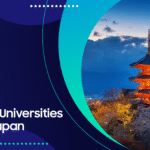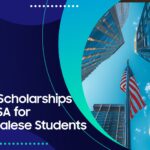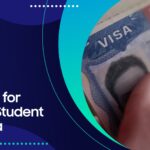Getting a student visa is your first and most crucial step toward studying in the USA, but for many Nepalese students, it’s also the hardest. In 2024 alone, over 16,700 Nepali students made it to top U.S. universities, but thousands more were denied. With the U.S. tightening visa scrutiny and nearly 41% of F-1 applications rejected globally, every detail now matters, from your finances to your interview answers.
The good news? With the right information and preparation, your dream is still within reach.
This blog is your complete, updated guide to the U.S. student visa process from Nepal. Visa types, eligibility requirements, fees, bank balance rules, and post-arrival tips, we’ve covered it all.
Hardford Education brings you this expert breakdown so you can apply with confidence and clarity. Let’s begin.
Types of Study Visa in USA
The U.S. offers several types of student visas depending on the purpose and type of study program. Choosing the right one is the first step in your visa journey. Here’s what each type means:
1. F1 Visa – Academic Studies
The F1 visa is the most common student visa issued by the U.S. government. It’s designed for students who wish to enroll in any of the:
- Universities or colleges
- High schools
- Language training programs
- Other academic institutions in the USA
With an F1 visa, you must be enrolled full-time, and your school must be authorized by the SEVP (Student and Exchange Visitor Program). You can also work part-time on campus during your studies and apply for OPT (Optional Practical Training) after graduation.
This is the visa most Nepalese students apply for when planning to study in the U.S.
2. M Visa – Vocational or Non-Academic Studies
The M visa is intended for students enrolling in non-academic or technical courses such as mechanical, vocational, or trade-based programs.
Unlike the F1 visa, the M visa has stricter rules when it comes to employment. You cannot work while studying under this category. However, if your goal is to gain practical skills through a short-term technical program, the M visa might be the right fit.
3. J Exchange Visa – Educational & Cultural Programs
The J visa is for exchange visitors, including students, interns, teachers, researchers, and scholars participating in programs that promote cultural exchange. If you’re applying through a government-funded or university-affiliated exchange program, this is likely the visa you’ll need.
J visa holders are usually supported by a sponsoring institution and may receive scholarships, research roles, or fellowships. You’re also allowed limited work opportunities under certain conditions.
F2 Visa – Dependents of F1 Visa Holders
If you’re an F1 visa holder planning to bring your spouse or children with you to the U.S., they’ll need an F2 visa.
F2 visa holders:
- Cannot work or study full-time (except for children at the K-12 level)
- Must depend entirely on the F1 student for financial and legal support
- Can stay in the U.S. for as long as the F1 visa remains valid
This visa allows families to stay together during your studies while keeping their immigration status legal and recognized.
How Many Years Can You Stay in the U.S. on a Student Visa?
Your stay in the U.S. on a student visa depends on the length of your program. Generally:
- For F1 visa holders, the stay is valid for the duration of the course plus an additional 60-day grace period.
- For M visa holders, it’s valid for the length of the course plus 30 days.
- Extensions can be applied for if you change programs or need more time to complete your degree.
Keep in mind that maintaining your visa status means keeping up with your academic program and complying with U.S. immigration laws.
How Much is the Study Visa Fee in USA?
Understanding the total cost of a student visa helps you plan better and avoid surprises during the application process. While the visa fee is fixed, there are other associated costs that every student should account for before heading to the U.S.
1. U.S. Student Visa Application Fees (from Nepal)
Here’s a breakdown of the main visa-related expenses:
|
Fee Type |
Cost (USD) |
Notes |
|
SEVIS Fee (I-901) |
$350 |
Paid after receiving your I-20 form |
|
DS-160 Visa Application Fee |
$185 |
Non-refundable, paid before visa interview |
|
VFS/Appointment Booking Fee |
Varies |
Depending on embassy scheduling platform |
These are the mandatory payments you must make before attending your student visa interview at the U.S. Embassy in Kathmandu.
If you are applying for a student visa for USA from Nepal, these are the first financial steps you’ll take after university admission.
Fast Fact
As you secure admission in an educational institution in the USA, your college or university will apply for an I-20 form on your behalf. You need this I-20 form as a confirmation of your enrolment and sufficient funds. I-20 form is also known as Certificate of Eligibility.
2. Other Essential Costs to Study in the USA
Besides the visa fees, you’ll also need to cover other expenses as part of your study plan. These include:
I. Admission Fee
- Most U.S. universities charge an application fee ranging from $50 to $100.
- Some institutions offer fee waivers for international students, which your consultancy can help request.
II. Tuition Fee
- Tuition varies widely depending on the program and institution:
- Community Colleges: $8,000 – $12,000 per year
- Public Universities: $15,000 – $25,000 per year
- Private Universities: $30,000 – $50,000+ per year
III. Minimum Bank Balance / Proof of Funds
You must show that you (or your sponsor) can afford your first year of education and living expenses. A typical bank statement for an F1 visa must show at least USD 25,000 – 35,000, depending on your college and city of stay. Funds must be recent, reliable, and held for a sufficient period (usually 28+ days) before the visa appointment.
A Bank Statement is a key requirement for your I-20 issuance and visa approval. Unclear proof of finances can lead to rejection. If you are not confident about your documentation, consult a trusted educational advisor to guide you with financial formats, and timelines.
What is the Requirement for a Student Visa in the USA?
To successfully obtain a U.S. study visa, you’ll need to meet both academic and immigration requirements. This includes receiving admission to a certified institution, preparing key documents, and understanding how different forms (like SEVIS, DS-160, and I-20) come into play.
Documents Required for Study Visa in USA
Here’s a list of the most essential documents needed during your visa application process:
- Valid passport
- Form I-20 issued by your U.S. university or college
- DS-160 confirmation page with barcode
- SEVIS fee receipt
- Bank statements (for financial proof)
- Admission letter from your U.S. institution
- Academic transcripts and certificates
- Standardized test scores (SAT, GRE, TOEFL, etc.)
- Visa appointment confirmation
- Passport-sized photographs (as per U.S. specifications)
Understanding the Key Documents – I-20, SEVIS, DS-160
To make your visa journey easier, here’s a quick explanation of what these important forms mean and why they matter:
1. Form I-20
- Issued by your chosen U.S. college after you’re accepted
- Proves your enrollment and eligibility for an F1 visa
- Lists your program, duration, and financial estimate for one academic year
- You’ll need this for SEVIS registration, visa interview, and at airport immigration
2. SEVIS (Student and Exchange Visitor Information System)
- This is a digital tracking system managed by the U.S. government
- Before your visa interview, you must pay the SEVIS I-901 fee
- SEVIS keeps records of your visa status, college changes, and legal stay in the U.S.
3. DS-160 Form
- This is the official U.S. visa application form, completed online
- You must submit it and print the confirmation page for your visa interview
- The DS-160 includes your personal details, travel plans, education background, and SEVIS ID
Is IELTS Required for USA Student Visa?
IELTS is not mandatory to apply for a U.S. student visa — the U.S. Embassy does not officially require any specific English test for the visa itself. However, most universities do require proof of English proficiency for admission purposes.
Common accepted tests include:
- IELTS
- TOEFL
- Duolingo English Test
- PTE Academic
Some universities may also waive the test if:
- You’ve studied in English medium institutions previously
- You meet GPA or interview-based language benchmarks
- You are willing to take English as a Secondary Language (ESL) courses in your chosen institution
Quick Tip
To find out the perfect test for yourself, explore all your test options, attend affordable classes, or talk to a counsellor to make an informed decision.
How to Apply for Your U.S. Student Visa in 2025?
Applying for a student visa for USA from Nepal involves several clear steps. While the process may look formal, it becomes straightforward once you know what to do, when to do it, and what documents to prepare.
Here’s a step-by-step guide:
1. Get Admission & Receive Form I-20
- Apply to SEVP-approved universities or colleges in the USA.
- Once admitted, your school will issue a Form I-20, which is essential for your visa process.
- Verify the details on the I-20 carefully, including program duration, funding estimate, and SEVIS ID.
2. Pay the SEVIS Fee (I-901)
- Before applying for your visa, pay the $350 SEVIS fee using your I-20 SEVIS number.
- Save the receipt, as you’ll need it during your interview.
3. Fill Out the DS-160 Form Online
- Visit the official U.S. visa website to complete the DS-160 form.
- Provide accurate information about your background, education, and travel purpose.
- After submission, print the confirmation page with the barcode — this is required for your visa appointment.
4. Schedule Your Visa Interview
- Create a profile on the U.S. Visa Appointment website.
- Pay the visa fee (around $185) and book your interview at the U.S. Embassy in Kathmandu.
- Choose a date that gives you enough time to organize your documents and prepare.
5. Attend the Visa Interview
- Visit the embassy on the scheduled date with all required documents.
- Be ready to answer questions about your chosen course, college, finances, and future plans.
- Confidence, honesty, and preparation are key.
Having a well-organized file and a clear explanation of your study and career goals increases your chances of visa approval.
Learn: F1 Visa Interview Questions & Answers – A Simple Guide
Prepare well for your interview, practice in mock sessions, and keep a sharp eye on your documentation. Be very precise when reviewing your application forms and documents – leave no chance for any mistake or typo.
Can We Work on a Study Visa in USA?
Yes, international students on an F1 visa are allowed to work in the United States , but under certain conditions. Understanding where, when, and how you can work is essential for both legal compliance and financial planning.
Working Hours & Minimum Wage for International Students in USA
- During academic terms: 20 hours/week (max)
- During vacation or authorized breaks: up to 40 hours/week
- Minimum wage: Varies by state, but typically $10–$15 per hour
Here’s a breakdown of your part-time work options:
1. On-Campus Employment
As an international student with F1-visa, you are allowed to work only on-campus jobs for the first academic year.
- You can work up to 20 hours per week during academic sessions.
- During holidays and vacation breaks, you can work full-time (up to 40 hours/week).
- Jobs are usually at the campus bookstore, library, cafeteria, or as research assistants.
No special authorization is required, but your school’s DSO (Designated School Official) must be informed.
You can also explore off-campus jobs once you reach your second academic year. The options are:
2. Curricular Practical Training (CPT)
- CPT allows students to take internships or work placements related to their field of study.
- It must be an integral part of your curriculum and approved by your academic advisor.
- CPT can be part-time (during studies) or full-time (in breaks or final semesters).
3. Optional Practical Training (OPT)
- OPT allows you to work for up to 12 months after completing your program.
- For STEM (Science, Technology, Engineering, Math) degrees, an extension of 24 additional months is possible.
- OPT work must be directly related to your course of study.
- Application is done through USCIS (U.S. Citizenship and Immigration Services) and should be submitted before your program ends.
4. Severe Economic Hardship
- In rare cases, F1 students facing unexpected financial difficulty may apply for off-campus jobs.
- Requires at least one year of full-time academic status and USCIS authorization.
- Only granted under serious, verifiable circumstances.
Can I Transfer to Another College in the United States?
Yes. If you’re studying in the U.S. on an F1 visa, you can transfer to another SEVP-certified institution. Common reasons for transferring include:
- Better programs or tuition offers
- Change of academic interest
- Relocation or scholarship opportunities
Your new school will issue a new I-20, and you must notify your current school’s DSO before transferring.
What to Do After You Land in the U.S. on an F-1 Visa?
Arriving in the United States is a big milestone, but what you do in the first few weeks is just as important as getting your visa approved. From university check-ins to visa compliance, here are the essential first steps and ongoing responsibilities every Nepali F-1 student should follow.
Within Your First Few Weeks
- Check in with your DSO (Designated School Official) within 30 days of arrival. This activates your SEVIS record.
- Enroll full-time study programs 12 credit hours for undergraduates, 9 for graduate students.
- Apply for your student ID, health insurance, and local transport pass through your university’s international office.
- Look for campus jobs. You’re allowed to work up to 20 hours/week during sessions.
- Understand your university’s health insurance. U.S. medical costs are steep; knowing what’s covered matters.
- Join a Nepali student group or support circle—they’ll help you adjust quicker and feel at home.
Ongoing Visa Responsibilities
- Always inform your DSO about changes in address, phone number, academic program, or school.
- Never work off-campus without prior CPT or OPT authorization.
- Renew your passport before it expires and keep your F-1 visa valid if traveling abroad.
- Follow U.S. laws strictly—even minor violations can endanger your visa status.
Managing visa regulations, part-time work, and university responsibilities can feel overwhelming, but you don’t have to figure it all out alone. With a with a strong start, ongoing awareness, and the right community, you can make your U.S. experience smooth and fulfilling.
At Hardford, we help students not just get into U.S. universities, but adjust, settle, and succeed once they’re there. If you have questions about OPT, document updates, or how to legally work during your course, we’re just a call away.
Feel ready with our pre-departure sessions and post-arrival support!
Post Study Work Visa in USA
One of the key attractions of studying in the United States is the opportunity to gain work experience after graduation. With the right visa and documentation, international students can legally remain in the U.S. and work in their field of study.
Let’s explore the available post-study work options for Nepalese students.
1. Optional Practical Training (OPT)
As introduced earlier, OPT is the most common route for students to work in the U.S. after completing their degree.
- You can apply for 12 months of full-time OPT after your graduation.
- Your job must be directly related to your major field of study.
- The OPT application must be submitted before your program ends and takes a few months to process.
- OPT is available after both bachelor’s and master’s degrees.
2. STEM OPT Extension (for Science, Technology, Engineering, Math Graduates)
- Students with STEM degrees can extend their OPT for an additional 24 months, making it a total of 36 months.
- You must work with an employer registered in the E-Verify system.
3. H-1B Work Visa (After OPT)
After your OPT period, you can apply for a work visa (H-1B) through employer sponsorship.
- It allows professional work for up to 6 years in total.
- The H-1B is lottery-based, and filing must be done by your employer.
Many international graduates in the U.S. start their careers through OPT and later transition to H-1B or other work-based immigration routes.
4. Employment Authorization via USCIS
The U.S. Citizenship and Immigration Services (USCIS) handles all work-related permits and post-study visa processing.
- Applications like OPT, STEM Extension, and change of visa status go through USCIS review.
- Timely filing and proper documentation are key to approval.
Can You Change a Tourist Visa to a Student Visa in the U.S.?
Yes, it’s possible—but risky, complicated, and often discouraged.
If you’re in the U.S. on a B1/B2 tourist visa and want to switch to a student visa, you’ll need to apply for a change of status through USCIS (Form I-539). You must also:
- Be accepted by an SEVP-certified school
- Receive a valid Form I-20 from your education provider
- Wait for USCIS approval before starting any classes
What You Must Know:
- You cannot begin studying until your change of status is approved.
- Approval can take several months, and there is no guarantee it will be accepted.
- You should apply at least 45–60 days before your current status expires.
- During the transition period, you cannot work or study unless approved.
- If you enroll in classes while on a visitor visa, it’s a violation of U.S. immigration law.
Risks Involved:
- Your application can be denied if it appears you had “preconceived intent” to study while entering on a tourist visa.
- Future visa renewals or travel entries could be affected.
Our Advice for Tourist/ Visitor Nepalese Applicants:
While many prospective students consider visiting the U.S. first and applying later, it is legally safer and faster to apply for an F-1 visa from Nepal with the right documents, proof of funds, and academic intent.
Need clarity on your case? Contact Hardford Education for expert visa consultations to help you choose the best path without risking rejection or legal issues.
Final Takeaway
Applying for a U.S. student visa is not just about paperwork—it’s about timing, precision, and the right strategy. Many rejections happen due to small errors, missing documents, or unclear intent.
But with expert guidance, your chances rise significantly.
At Hardford, we’ve helped hundreds of Nepalese students secure admissions, prepare for tests, and succeed in visa interviews. From your first form to your final flight—we stay with you every step.
Let’s make your U.S. education plan real.
Book a FREE Consultation Today!
Frequently Asked Questions – Student Visa in USA from Nepal
1. How much is a student visa for USA from Nepal?
The total cost for US student visa application includes two main fees: the SEVIS fee of USD 350 and the visa application fee of USD 185. Together, Nepalese students pay approximately USD 535 for the F-1 student visa process. Besides, students may be required to pay an admission fee and tuition for the first year.
2. Which visa is best for students in the USA?
For most Nepalese students pursuing academic degrees, the F‑1 visa is the top choice. It permits full-time enrollment at SEVP-approved universities, allows on-campus work, and qualifies for post‑study work options like OPT and STEM OPT. The M‑1 visa is for vocational programs, while J‑1 visas are for exchange and cultural scholarship programs.
3. How many years post study visa in USA?
The post‑study OPT duration is 12 months, with an optional 24‑month extension available for STEM degree holders (total 36 months). After OPT, graduates often attempt to transition to H‑1B visas or other work-based immigration paths.
4. What is the maximum age for a student visa in the USA?
There is no official upper age limit set for F‑1 visa applicants. However, applicants at extreme ages may undergo additional scrutiny regarding their education goals. Interview waiver rules were tightened in 2025, and individuals under 14 or over 79 typically require in-person interviews.
5. Which student visa is easiest to get in the USA?
While no visa is “easy,” the F‑1 visa is the most commonly approved for academically qualified applicants with strong documentation. Approval depends on acceptance by a SEVP-accredited school, accurate financial evidence, and genuine study intent. J‑1 or M‑1 visas may require more specialized documentation or sponsors.
6. Is IELTS required for a USA visa?
IELTS is not mandatory for the visa itself, but most U.S. universities require proof of English proficiency (e.g., IELTS, TOEFL, Duolingo, or PTE). Some schools may waive this if you studied in English-medium institutions or meet other criteria.
7. How much bank balance is required for a USA student visa from Nepal?
You need to show proof of funds to cover your first year of tuition plus living expenses. Typically, this ranges from US $25,000 to $50,000, depending on the institution and location. Bank balance must be recent and sustained.
8. What are the minimum requirements for a USA student visa?
Key requirements include:
- Admission by a SEVP-approved school and receipt of Form I‑20
- Payment of SEVIS I‑901 fee (US $350)
- Submission of DS‑160 online, and US $185 visa fee payment
- Documents: valid passport, admission letter, I‑20, DS‑160 receipt, SEVIS receipt, financial proof, academic records, and proof of English proficiency (if required)
- Proof of intent to return to Nepal after studies.
9. How much percentage is required to study in the USA from Nepal?
Typically, universities expect around 60% (2.6 GPA) in +2 for undergraduate programs and a similar or slightly higher score from previous degrees for graduate studies. Competitive institutions may require 70% or higher, or strong SAT/GRE scores to offset lower percentages.
Also Read:
Affordable Universities in USA for International Students
Scholarship in USA for Nepali Students: Complete 2025 Guide









